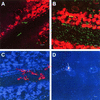Fitness of Salmonella enterica serovar Thompson in the cilantro phyllosphere
- PMID: 12089050
- PMCID: PMC126799
- DOI: 10.1128/AEM.68.7.3614-3621.2002
Fitness of Salmonella enterica serovar Thompson in the cilantro phyllosphere
Abstract
The epiphytic fitness of Salmonella enterica was assessed on cilantro plants by using a strain of S. enterica serovar Thompson that was linked to an outbreak resulting from cilantro. Salmonella serovar Thompson had the ability to colonize the surface of cilantro leaves, where it was detected by confocal laser scanning microscopy (CLSM) at high densities on the veins and in natural lesions. The population sizes of two common colonizers of plant surfaces, Pantoea agglomerans and Pseudomonas chlororaphis, were 10-fold higher than that of the human pathogen on cilantro incubated at 22 degrees C. However, Salmonella serovar Thompson achieved significantly higher population levels and accounted for a higher proportion of the total culturable bacterial flora on cilantro leaves when the plants were incubated at warm temperatures, such as 30 degrees C, after inoculation, indicating that the higher growth rates exhibited by Salmonella serovar Thompson at warm temperatures may increase the competitiveness of this organism in the phyllosphere. The tolerance of Salmonella serovar Thompson to dry conditions on plants at 60% relative humidity was at least equal to that of P. agglomerans and P. chlororaphis. Moreover, after exposure to low humidity on cilantro, Salmonella serovar Thompson recovered under high humidity to achieve its maximum population size in the cilantro phyllosphere. Visualization by CLSM of green fluorescent protein-tagged Salmonella serovar Thompson and dsRed-tagged P. agglomerans inoculated onto cilantro revealed that the human pathogen and the bacterial epiphyte formed large heterogeneous aggregates on the leaf surface. Our studies support the hypothesis that preharvest contamination of crops by S. enterica plays a role in outbreaks linked to fresh fruits and vegetables.
Figures






Similar articles
-
Production of autoinducer 2 in Salmonella enterica serovar Thompson contributes to its fitness in chickens but not on cilantro leaf surfaces.Appl Environ Microbiol. 2005 May;71(5):2653-62. doi: 10.1128/AEM.71.5.2653-2662.2005. Appl Environ Microbiol. 2005. PMID: 15870357 Free PMC article.
-
Effect of the surfactant tween 80 on the detachment and dispersal of Salmonella enterica serovar Thompson single cells and aggregates from cilantro leaves as revealed by image analysis.Appl Environ Microbiol. 2014 Aug;80(16):5037-42. doi: 10.1128/AEM.00795-14. Epub 2014 Jun 6. Appl Environ Microbiol. 2014. PMID: 24907336 Free PMC article.
-
Plant-mediated restriction of Salmonella enterica on tomato and spinach leaves colonized with Pseudomonas plant growth-promoting rhizobacteria.Int J Food Microbiol. 2017 Oct 16;259:1-6. doi: 10.1016/j.ijfoodmicro.2017.07.012. Epub 2017 Jul 27. Int J Food Microbiol. 2017. PMID: 28778009
-
Specific Environmental Temperature and Relative Humidity Conditions and Grafting Affect the Persistence and Dissemination of Salmonella enterica subsp. enterica Serotype Typhimurium in Tomato Plant Tissues.Appl Environ Microbiol. 2019 May 16;85(11):e00403-19. doi: 10.1128/AEM.00403-19. Print 2019 Jun 1. Appl Environ Microbiol. 2019. PMID: 30926732 Free PMC article.
-
The salmonella transcriptome in lettuce and cilantro soft rot reveals a niche overlap with the animal host intestine.Appl Environ Microbiol. 2013 Jan;79(1):250-62. doi: 10.1128/AEM.02290-12. Epub 2012 Oct 26. Appl Environ Microbiol. 2013. PMID: 23104408 Free PMC article.
Cited by
-
Detection of plant-modulated alterations in antifungal gene expression in Pseudomonas fluorescens CHA0 on roots by flow cytometry.Appl Environ Microbiol. 2008 Mar;74(5):1339-49. doi: 10.1128/AEM.02126-07. Epub 2007 Dec 28. Appl Environ Microbiol. 2008. PMID: 18165366 Free PMC article.
-
Novel molecular components involved in callose-mediated Arabidopsis defense against Salmonella enterica and Escherichia coli O157:H7.BMC Plant Biol. 2020 Jan 8;20(1):16. doi: 10.1186/s12870-019-2232-x. BMC Plant Biol. 2020. PMID: 31914927 Free PMC article.
-
Salmonella enterica Elicits and Is Restricted by Nitric Oxide and Reactive Oxygen Species on Tomato.Front Microbiol. 2020 Mar 13;11:391. doi: 10.3389/fmicb.2020.00391. eCollection 2020. Front Microbiol. 2020. PMID: 32231649 Free PMC article.
-
Bacterial community diversity and variation in spray water sources and the tomato fruit surface.BMC Microbiol. 2011 Apr 21;11:81. doi: 10.1186/1471-2180-11-81. BMC Microbiol. 2011. PMID: 21510867 Free PMC article.
-
Leaf age as a risk factor in contamination of lettuce with Escherichia coli O157:H7 and Salmonella enterica.Appl Environ Microbiol. 2008 Apr;74(8):2298-306. doi: 10.1128/AEM.02459-07. Epub 2008 Feb 29. Appl Environ Microbiol. 2008. PMID: 18310433 Free PMC article.
References
-
- Campbell, V. J., J. Mohle-Boetani, R. Reporter, S. Abbott, J. Farrar, M. T. Brandl, R. E. Mandrell, and S. B. Werner. 2001. An outbreak of Salmonella serotype Thompson associated with fresh cilantro. J. Infect. Dis. 183:984-987. - PubMed
-
- Cook, K. A., T. E. Dobbs, W. G. Hlady, et al. 1998. Outbreak of Salmonella serotype Hartford infections associated with pasteurized orange juice. JAMA 280:1504-1509. - PubMed
-
- Davies, R. H., and C. Wray. 1995. Observations of disinfection regimens used on Salmonella enteritidis infected poultry units. Poultry Sci. 74:638-647. - PubMed
-
- Hedberg, C. W., F. J. Angulo, K. E. White, C. W. Langkop, W. L. Schell, M. G. Stobierski, A. Schuchat, J. M. Besser, S. Dietrich, L. Helsel, P. M. Griffin, J. W. McFarland, and M. T. Osterholm. 1999. Outbreaks of salmonellosis associated with eating uncooked tomatoes: implications for public health. Epidemiol. Infect. 122:385-393. - PMC - PubMed
Publication types
MeSH terms
Substances
LinkOut - more resources
Full Text Sources
Molecular Biology Databases

